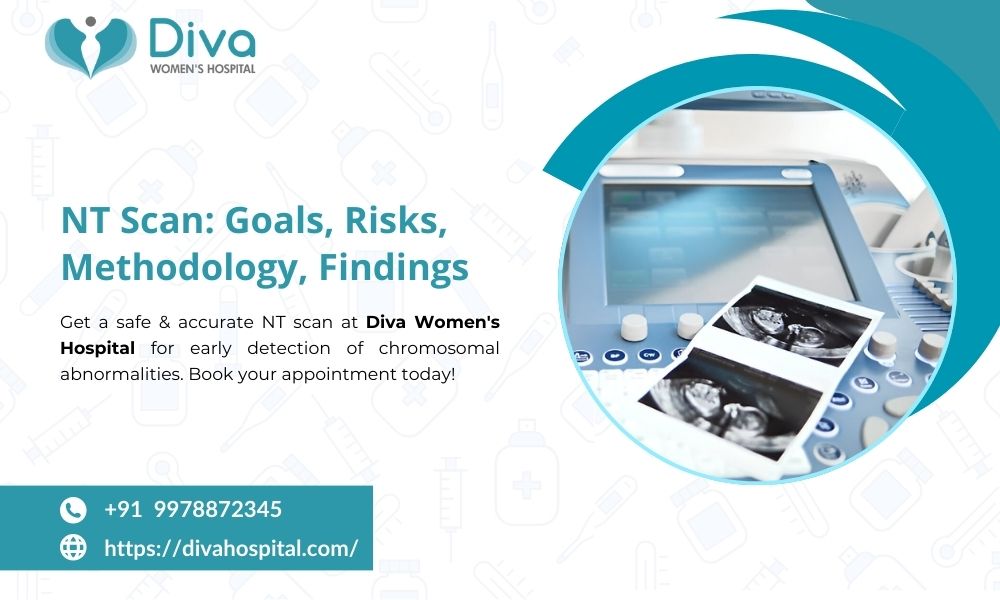Applied in the first trimester of pregnancy, a Nuchal Translucency (NT) scan is a crucial prenatal screening tool. This non-invasive ultrasonic scan detects in the developing foetus the risk of chromosomal abnormalities including Down syndrome (Trisomy 21), Edwards syndrome (Trisomy 18), and Patau syndrome (Trisomy 13). Early in pregnancy, the NT scan is a straightforward but efficient method to evaluate the baby’s condition; it also lets parents be ready for additional tests when needed.
Expert prenatal tests including NT scans are available at Diva Women’s Hospital to guarantee the welfare of mother and child. Everything you need to know about Nuchal Translucency Scans—including their goal, technique, hazards, and outcomes—will be covered on this blog.
What is an NT Scan?
Between 11 to 14 weeks of pregnancy, a Nuchal Translucency (NT) Scan is a specialist ultrasonic exam. It gauges nuchal translucency—that is, the fluid-filled area at the rear of the baby’s neck. The thickness of this area aids in determining the likelihood of congenital heart problems and hereditary diseases.
Should the nuchal translucency measurement be above average, this could suggest a greater likelihood of some chromosomal abnormalities. An NT scan merely indicates the need for more testing; it does not establish a diagnosis.
Goal of an NT Scan
There are various reasons the NT scan is done, among them:
- Screening for Chromosomal Abnormalities: This aids in the detection of Patau syndrome, Edwards syndrome, and Down syndrome risk.
- Evaluating Baby’s Development: The scan aids in determining the baby’s size, heart rate, and developmental state.
- Finding Structural problems: Sometimes an NT scan might assist in identifying congenital disorders or cardiac problems.
- Guiding Further Testing: Should the NT level suggest a rise, clinicians could advise further tests for a more accurate diagnosis like non-invasive prenatal testing (NIPT), chorionic villus sampling (CVS), or amniocentesis.
At Diva Women’s Hospital, we make sure parents get professional advice and clear explanations on their NT scan findings.
When is an NT Scan Done?
Usually, the NT scan comes between eleven and fourteen weeks of pregnancy. This period is perfect as, before 11 weeks, the baby is too little to collect reliable measurements; after 14 weeks, the fluid in the nuchal translucency starts to be absorbed, which makes risk assessment challenging.
Since this makes the first trimester the optimal period for an NT scan and offers the most consistent screening findings.
Procedure of an NT Scan
An NT scan is a basic non-invasive ultrasonic exam carried out under trained sonographer direction.
Step-by-Step NT Scan Method:
- Preparation: There is no special preparation required, but having a full bladder may help improve ultrasound clarity.
- Positioning: The patient lies down, and the doctor applies ultrasound gel to the abdomen.
- Ultrasound Imaging: A transducer (ultrasound probe) is moved over the belly to capture images of the baby.
- Measurement: The doctor measures the thickness of the nuchal translucency (fluid-filled space) at the back of the baby’s neck.
- Assessment: The NT measurement is combined with maternal age and blood test results to estimate the risk of chromosomal abnormalities.
- Duration: The procedure usually takes about 20–30 minutes.
If the baby is not in the correct position for measurement, the mother may be asked to change positions or walk around before continuing the scan.
Interpreting NT Scan Results
The NT scan findings expressed in millimetres (mm) are a measurement. Though often less than 3.5 mm – Considered a normal result, indicating a lower risk of chromosomal abnormalities – more than 3.5 mm – May indicate a higher risk and need for additional diagnostic procedures.
What Happens If My NT Scan Shows an Increased Risk?
Should the NT measurement be high, this does not indicate the kid has a hereditary condition. Additional procedures, like non-invasive prenatal testing (NIPT), a basic blood test analysing foetal DNA for genetic disorders, could be advised though.
Amniocentesis is a technique used to verify chromosomal abnormalities in amniotic fluid; Chorionic Villus Sampling (CVS) is a test of placental tissue for such disorders.
Our experts at Diva Women’s Hospital offer thorough prenatal counselling to assist in the understanding of NT scan results and guide decisions made by parents.
Is an NT scan secure?
For both mother and child, an NT scan is indeed entirely safe. Being a non-invasive ultrasonic, there is no chance of infection, bleeding, or miscarriage.
✔ No radiation exposure
✔ Easy and rapid technique
✔ dependable first-trimester screening instrument
Should the NT scan indicate a higher risk, further diagnostic investigations can offer more comprehensive details regarding the state of the infant.
Benefits of an NT Scan
Early Detection: Shows first trimester concerns for chromosomal abnormalities; Non-Invasive: Totally safe with no risk to the unborn child. A normal NT scan result can reassure parents about the health of their child and help doctors determine whether further tests are required.
Choosing Diva Women’s Hospital for your NT scan guarantees caring advice, modern technology, and professional treatment all during your pregnancy.
Crucially first-trimester screening test for assessing baby risk of chromosomal disorders is a Nuchal Translucency (NT) Scan. Although a high NT value might point to a higher risk, a clear diagnosis calls for more testing.
To guarantee the greatest health outcomes for mother and child, Diva Women’s Hospital offers precise NT scans, knowledgeable interpretation, and individualised pregnancy care. Require an NT scan? Set up your visit to Diva Women’s Hospital right now!

